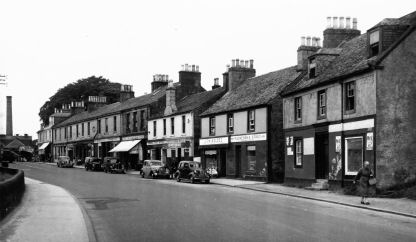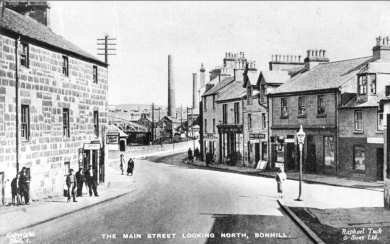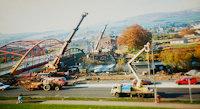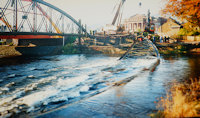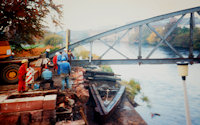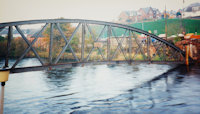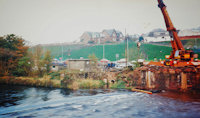BONHILL PAGE 5
PAGE 1 | PAGE 2 | PAGE 3 | PAGE 4
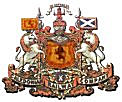
In 1889 the Caledonian Railway announced plans to end the railway monopoly of its deadly rival, the North British Railway, on the north side of the Clyde, a main component of which was the Glasgow - Balloch railway line. The North British lines north of the Clyde were the largest remaining railway monopoly in Scotland at that time, and the Caley as it was called was deadly serious about ending that monopoly, as it was to prove. Its proposal was for a completely new line from Glasgow Central station running close to the yards and factories of the Clyde, unlike the NB line, which tended to meander through the leafier suburbs of Glasgow.
The northern section of the route was to run from Dumbarton along the east side of the Vale through Bonhill, Jamestown and Gartocharn to a terminus somewhere about the Aber shore. The Caley further announced that it planned to use this terminus as a port for its own fleet of steamers, which it was going to introduce onto the Loch. The NB seems to have had advanced information about the plans, because even before their announcement it bought the Lochlomond Steamship Company which operated the existing steamer fleet on the Loch. As part of the new railway line, Bonhill was to get a new station somewhere about the new George Street / the Burn.
The Caley's proposals caused great excitement in the Vale and were universally welcomed by the whole Vale community (except perhaps the Smolletts and Colquhouns who were still at this stage collecting
bridge tolls) not just the people 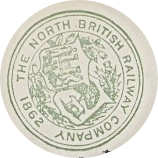 of Bonhill. In part, this was because the NB was pretty universally detested in the Vale because of the unreliability of the service, their prices and an approach to
customer service, which seems depressingly modern.
of Bonhill. In part, this was because the NB was pretty universally detested in the Vale because of the unreliability of the service, their prices and an approach to
customer service, which seems depressingly modern.
Naturally, the NB vehemently opposed the whole Glasgow - Aber line and the review of the proposed new line dragged on for years. However, there was little sympathy or support from anyone in the west of Scotland about the larger plan. It was obvious to many, and to the money men in particular, that the Vale section of the line was going to struggle for economic viability, while many questioned whether there was enough business on the Loch to support two competing steamer fleets. Bonhill was the only town or village of any size on the last section of the line as it passed through a sparsely populated rural area. It was also noted that the Vale factories also had existing railway facilities some of which such as at Dillichip and Dalmonach had been purpose built for them.
In 1896, an arbitration agreement was made between the two railway companies - the Glasgow - Dumbarton section of the line would go ahead, but the Dumbarton - Aber section would not. Instead a new company was formed to operate the existing line between Balloch and Dumbarton (but not the trains) and also the steamers on the Loch. This new company was jointly owned by the Caley and NB and survived until railway nationalisation in 1947.
Naturally enough the Vale was disappointed, particularly the people of Bonhill. Cynics said that the Caley was never really serious about the section of line through Bonhill to the Aber and they only used it to achieve their real objective, which was a share of the action to Balloch and on Loch Lomond. The final settlement of a jointly owned line between Balloch and Dumbarton and joint ownership of the steamers was probably what the Caley had been aiming for in the first place and the cynics were probably nearer the truth than they perhaps realised.
There are a number of “what if?” questions around the proposals, but the mostly like outcome was that the economics would have seen the line close to passengers in the 1930's just like the Jamestown line, and goods would not have survived any longer than that with the Works closures of the 1920's and 30's.
The turn of the 20th century saw two new developments above Main Street at the northern end of Bonhill. The first of these was the building of the villas on a newly laid out Dalmonach Road. Before the road could be built, the burn, which had previously run down, it from the hillside had to be covered in. Over the years this culvert was to prove prone to flooding and it was not until the 1970's that its problems were finally resolved. In 1900 the Co-op built the red sandstone terrace buildings in Union Street, and between Union Street and Dalmonach a new community was created at the north end of the town.
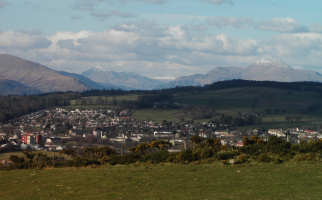 A few years later, in 1907, a new 9-hole golf course was opened at Northfield on a piece of land, which was leased by the club members. This was and still is the Vale of Leven Golf Club.
A few years later, in 1907, a new 9-hole golf course was opened at Northfield on a piece of land, which was leased by the club members. This was and still is the Vale of Leven Golf Club.
< Click Image to Enlarge
It was steadily enlarged from the beginning and has been an 18-hole course since the 1920's. In 1950 the Club bought the land from the Crum Ewing Estate, who were disposing of their landholdings in the Vale, having already sold Strathleven Estate and House, which they had owned for over a century. The Golf Course extends along the hillside above the northern end of the Vale, and has truly spectacular views of both the Loch and the hills beyond. If the golf is not going well, then the scenery is more than adequate compensation.
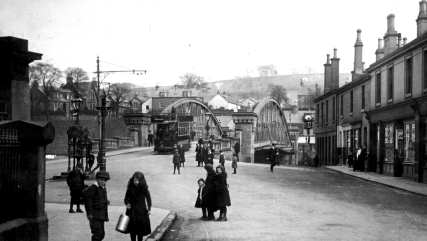
"The Jimsun Caur" crosses Bonhill Bridge (Click to Enlarge)
In 1908 the tram came to Bonhill - well a few yards of it anyway. The “Jimsun caur” which ran from the Fountain to the Railway station at Jamestown was inaugurated as part of the Dalmuir - Balloch tramway, which ran on the west side of the Vale. Although it was a double-deck tram, no passengers were allowed on the open upper deck because of the safety hazard posed by the low railway bridge in Bank Street Alexandria. This was probably just as well, because it is claimed that a major diversion for the residents of the Canon Row was to hurl abuse, and worse, at passengers on the tram, particularly on a Saturday when country folk came to Jamestown by train to do their shopping in Alexandria. The trams only lasted until 1928, when buses replaced them.
(See separate contribution on Trams in the Vale of Leven)
Bonhill people made the same contribution to the First World War as everyone else, and the names of Bonhill men who were killed are inscribed on the War Memorial in the Christie Park. During the war, the Parish Church Hall was used for billeting soldiers, just as Dalmonach Works buildings were in the Second World War.
Social conditions were probably worse in Bonhill by the early 20th century than in any other part of the Vale. The outbreak of typhoid in Braehead as late as 1900, as well as other infectious diseases such as small pox, just before that, has already been mentioned. Sanitary and housing conditions generally were pretty bad, and the open Burn was also a major health risk, since it acted as both sewer and informal water source. After the First World War there was a willingness to tackle these problems and also more radical local councillors such as Dan O'Hare emerged to fight for improvements.
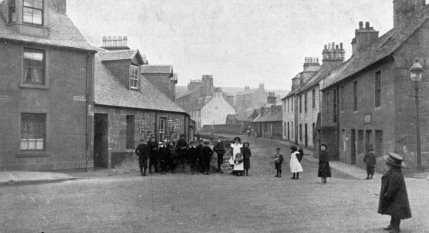
Children at Burn Street, Bonhill with the open burn in the background (Click to Enlarge)
Bonhill received its share of the first round of council house building in the Vale. New council estates were built in both George Street and Hillbank in the 1920's, on what were green field sites. The George Street houses were built on the remaining part of the old Ladyton Park. The new council houses in turn led to slum clearance elsewhere in Bonhill, including in Main Street and the Burn. Some of the cleared sites on Main Street in Braehead had new council three-storey tenements built on them in the 1930's, while in other cases, the gap sites remained just that - gaps.
1929 was the year of the Great Crash, which started off the worldwide depression of the 1930's that had such a savage impact in the Vale. All of the remaining Vale textile factories were badly affected, Dalmonach most of all. It was closed by the CPA and was never re-opened by them. Naturally, this was a devastating blow to Bonhill, and while Dillichip staggered on for a while, it too closed in 1936. Hard times had indeed arrived for Bonhill, and stayed until the outbreak of the Second World War and beyond. Indeed, just about the only positive point in these years was that the Burn was at last enclosed in a culvert, and the era of highly infectious diseases was over.
When the Second World War broke out, Dalmonach was requisitioned by the army to serve as a barracks for the army. Most of the units that came to Dalmonach were from English regiments and came to train
in the surrounding  countryside. Many of the soldiers met and married local girls and they stayed on after the war.
countryside. Many of the soldiers met and married local girls and they stayed on after the war.
The surrounding countryside had another wartime use. In the hills around the Pappert, anti-aircraft guns were positioned for the defence of Clydeside, while just beyond them was a successful piece of deception - an oil pipeline grid was laid out which mimicked a burning town at night. During the raids on Clydeside in 1941, this decoy was lit and many bombs fell there, which would otherwise have hit Clydebank or Glasgow. Bonhill was not hit although the bomb craters started at the Plantation / Black Woods and were visible for 30 years afterwards.
The general economic revival after the Second World War saw Bonhill share in the Vale's recovery and general prosperity from the 1940's to the 1980's. There were many signs of this. Perhaps the first was the building of Dalmonach Housing Estate from about 1947 onwards. The new houses in Bonhill in the 1920's and 30's had certainly helped at the time, but the returning servicemen and the post-war baby boom created great pressure on the Vale's housing stock for the next 20 years.
Dalmonach and Tullichewan estates were the first new post-war council estates, and Dalmonach had a mixture of aluminium and conventional housing probably in a 30:70 ratio. The new tenants came not only from Bonhill but also from other parts of the Vale, and from further afield, because some of the houses were reserved for “key-workers” at the new factories in the new Strathleven Industrial Estate.
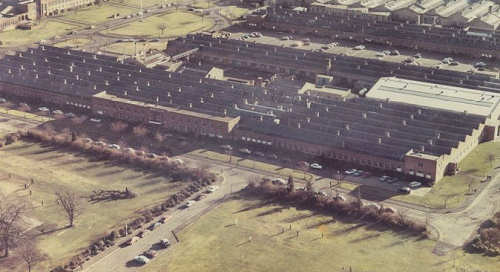
Strathleven Industrial Estate around 1960. The green areas in
the
foreground are where Polaroid plant and car parks were built.
No new schools were built, putting great pressure on Bonhill, Jamestown and St Mary's Schools, but they have all survived it. About the only downside to the new Dalmonach Estate was that the Slunger, one of the Vale's best-known and best-loved tracks and walks disappeared under a new Northfield Road.
Another positive sign was that when the army vacated Dalmonach Works about 1946, a number of other organisations stepped in to make use of the old buildings. While the site never again employed anything like the 800 or so people it had employed at its peak, it did provide work for probably a couple of hundred - a figure which would be very welcome to-day in the Vale. Companies, which were based there, included
- The Vale fire station - a full time unit in those days - was located there from the 1940's until the new fire station was built in Dumbarton in the late 1950's, when the units were transferred there.
- Paddy Caulfield's sand and quarrying business was based there for many years after the war and his fleet of lorries was garaged there.
- J & W Greig wool merchants, whose name could be seen on the side of one of the buildings beside the main road until May 2006, ran a busy operation from the 1950's.
- There were various garages on the site over the years, the last of which was Alan Methven's car repair business which was there until 2006 when it relocated to North Street Alexandria.
- Reid & Robertson's agricultural supply business was based in Dalmonach for many years, until it moved to the former Ballagan bus garage in 2006
Many other small businessmen prospered in Bonhill after the war. People such as Joe Proctor with his lorry, Dick Richmond, who went round the streets selling briquettes, and his deadly rivals in the briquette business, the Baxter Brothers. Paul's car body repair shop was at the corner of George Street and Campbell Street, while when Ian McColl hung up his football boots with Rangers and Scotland, he opened a garage at the bottom of Bonhill Brae. Baldy Murray had a scrap yard business at the corner of Campbell Street overlooking the burn. Bonhill tradesmen included Duncan Rogers the plumber, and the Smith brothers who had a slater and plasterers business with a yard at the top of the cat's loan, and the Murdoch family who were also slater and plasterers.
The shops and pubs on the Main Street enjoyed a post war revival, which lasted for many of them almost until they all disappeared in the wrong-headed road re-alignment of the 1980's. A listing of Bonhill's shops and pubs from the era of 1945 - 55 shows that there were nearly 40 of them. This is just a snapshot in time, which makes no claims to be completely accurate, but is a pretty good first attempt. Since many of the premises changed occupancy during this time, and went by a number of names, other people will probably have slightly different recollections, and we'd be delighted to hear about them.
From the Dummy Stairs south these shops included...
- Myrna Dawson's hairdressers, behind which was Dr Swanson's surgery
- And then Robert Dawson's fruit shop
- Palombo's fish and chip shop, which before that had been a pub until well after the war. Not sure what its name was, but at one stage it was McDougall's.
Added: Hi, just been reading about shops/pubs on Main St. Bonhill,I remember if you looked closely above Palombos chippie you could see "The Rising Sun" painted on the wall, this seemed to be the name of the pub, hope this can be of some assistance to your site.
Benjy Boyle 27 May 2009
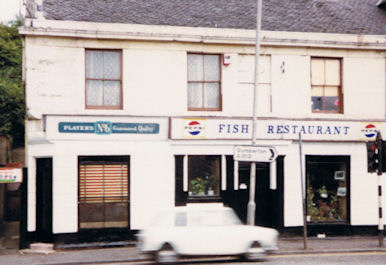
The Fish and Chip Shop at Bonhill Bridge around 1980. This was laterally
Gerry Notini's but perhaps better known as "Nancy's" (Nancy Palombo).
- Jean Parlane's Ladies Outfitters
- The Sportsman's Bar where Malcolm Nicholson was the proprietor until he moved back to Glen Varragil in Skye. The Sportsman's became the Grapes when the Boardmans had to move from their pub called the Grapes in Main Street, Alexandria when that was redeveloped.
- Next to it was McDonald's china shop, which went by the nickname of the “Chanty Shop” for obvious reasons
- Jimmy Rogan's barber's shop. Jimmy was helped by John Carmichael on a Saturday
- Boyd's cobbler's shop
- D.M. MacPhail's clothes shop, which was owned by the Carrick family
- The Post Office was next. A Mrs Murphy, whose husband was called Willie, owned it. After the Murphy's it passed into the hands of the McLaughlins
- Narducci's Ice Cream shop, which was more commonly known as Narr's or Nardush's).
(Update: We were contacted by Antony Valente, who explained that "Narducci's" was actually owned by Leonarda Palombo. Narducci is actually a misnomer. Nar and Nardush are diminutives of the name Leonarda in Italy. Thanks to Antony for explaining that.) - Stewart Mirrlees' licensed grocery
- John Green's electrician's shop
- Then there was a gap site until the Eagle Inn, which was at this time owned by Jack Newcombe before being taken over by ex Celtic goalkeeper Evan Williams.
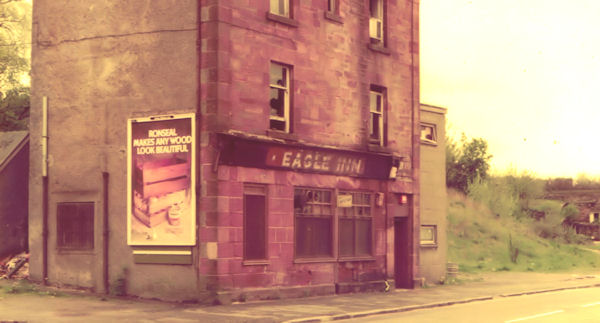
The Eagle Inn
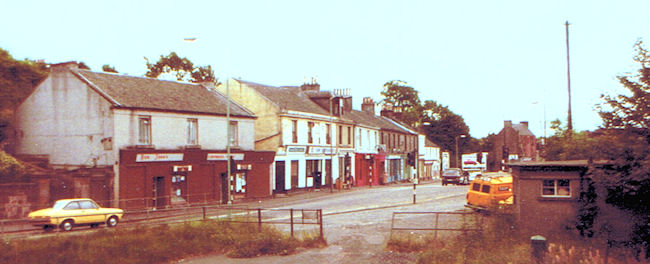
Another view of the Shops at Bonhill taken around 1980.
Most of these shops survived into the late 1970's / early 1980's. The shops that stood beyond the Eagle Inn, some of which ran round into Burn Street, were demolished much earlier than that. These included...
- Graham's the baker, which had a bakehouse at the back, although by this time it was probably used mainly as a storeroom
- Eddie Irwin's paint shop
- Hannah the butcher
- John Angus the baker
- Bob Feggans bicycle shop
- Johnny Ewart's hardware store
- Mrs Hendry's tearoom and bakery
Beyond Mrs Hendry's tearoom on the north side of Burn Street were some old single-storey low cottages, and then a couple of large red sandstone tenements.
On the south side of Burns Street, but on the Main Street, the shops resumed as follows.
- Louis McCaskell's chip shop. Louis', as it was universally known, vied with Melly Biagi's for the unofficial title as the best chip shop in the Vale. When Melly retired, Louis
reigned as undisputed champion for many years. People came from far and wide to buy Louis' fish and chips. It was not uncommon to see cars parked all the way up Bonhill brae while people waited in
the queue, which often stretched outside the shop. (Louis's real surname was Louis Franchi but McCaskell was bestowed upon him by the people of Bonhill.)
Added: He was given the name because the chip shop was in one of the McCaskel buildings in Bonhill. The McCaskel's owned a farm and dairy in the area and rented one of the shops to Louis for his fish and chip shop. The story goes that a sign painter made a mistake when spelling McCaskel and put in two L's at the end, which is when my family's name became McCaskell. (Information received from Stewart McCaskell October 2010.) Louis was also said to actually look like a MacCaskell making the sobriquet even more appropriate. - The Red Cross shop, which then became the Luminisers or Luminosity. This was a small operation making luminous clock and watch faces dials for the then booming Westclox factory in the Strathleven industrial estate.
- The Bonhill Pawn shop was next with its three balls sign.
- A row of Co-op shops were located on the brae. What they sold changed a number of times, but there was certainly a grocery for all of this time. In the fifties and sixties there was also a butcher's, a shoe shop and a baker's.
- At the top of the brae and well into Braehead was the Black Bull Inn, which at this time was owned by Eddie McMeekin. Bonhill Quoiting Club played at the back of the Bull on land owned by pub. The Bull survived very successfully under a number of owners, until the landlord was murdered and it was damaged by fire in 2000. It was demolished shortly afterwards
- Richardson the baker's was more or less opposite the school and was the last shop on the east side of Main Street.
_sm.jpg)
This image was probably taken from the old Bonhill bridge. It shows the parish church. On the extreme left we
can see the old Bonhill Brae before the redevelopment took place. The old church hall is visible along with the
Beadle's house. Louis's fish and chip shop is the lower of the two white buildings. The one above this
is the old Black Bull pub. (Click image to Enlarge)
Going back north again on the other (west) side of the street, the first retail premises were...
- A bank branch, don't know which bank. It stood just south of the toilets, close to where Moir's Bank, the first in the Vale 100 years before
- Then there was Jimmy Buntine's newsagents and tobacconist's shop, which later passed into George McLean's hands and then the McLeans who were related to the Buntines.
There were the two churches and some houses but no shops for hundreds of yards on the west side of the Main Street. Then approaching the school, there were two shops.
- Robertson's the general store owned by Bill Robertson who in the fifties and early sixties also delivered groceries in his van to the new Mill of Haldane housing scheme and other places.
- Next up was Houston's sweetie shop, which was more or less next to the school.
- Anderson's Dairy stood at the top of Dillichip Loan, and as well as milk, etc. it sold sherbet to children. In later years it passed into the late Peter McColl's hands. Peter's son-in-law, Jim McCarry, currently operates his home removal business from the same site.
- Jimmy McAdam's general store in Dillichip Terrace was the last shop on Main Street in Bonhill.
There was only one other shop in Bonhill at this time - Finlayson's in George Street, which like a few other small shops started out as a wooden hut. It passed on to George street resident Gertie Mooney and in the 50's it was sold to Johnnie Allen and later to another George Street resident, George McGinty.
As Dalmonach Estate was completed, three shops were opened there.
- Jim McLean who also had the shop at the bottom of the brae in Main Street opened one in Burn Street at the edge of the Dalmonach Estate, and it is only in the last few years that Jim has sold this shop.
- On First Avenue the Kippen Dairy had a shop and they also had one on Woodside Crescent/Northfield Road at the north end of the Estate.
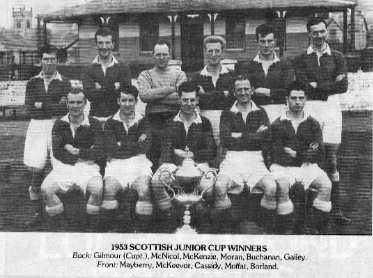
The 1950's were certainly the good times for Bonhill, and kicked off a “feel-good” factor, which lasted for many years. A number of things contributed to this. Firstly, as already noted housing problems were greatly eased by the building of Dalmonach housing estate. Then there were events like the Bonhill Parish Pipe Band winning the Cowal Pipe Band Championship on Saturday 30th August 1952, which was the de facto championship of the world. The next year, 1953, the Vale Juniors won the Scottish Junior Cup just before the Queen's Coronation in June 1953. The great boost to public morale from the Cowal Champions leading the Junior Cup winners through streets decked out with flags and buildings illuminated for the Coronation may be difficult to recapture now, but was very real to everyone at the time.
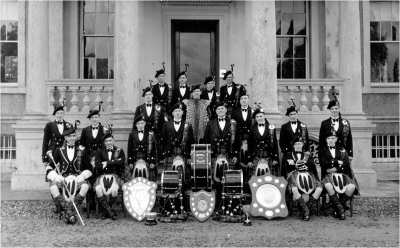
Bonhill Parish Pipe Band (c 1946) taken in front of Strathleven House.
This is the first post-WW2 “team photo” which we have of the of the Band.
(Click to Enlarge)
Let us see if we can fill in the missing names of the bandsmen here. Please let us know if you can identify any of the band members and when the picture was taken.
The people we can identify are as follows:
2nd back row. Wearing the leopard skin coat to protect his uniform is the Bass Drummer, William McLean of Clydebank. On his immediate left is Piper Jimmy Jackson (later the Pipe Major of the Band).
2nd front row. 4th from the left is Piper Donald Gillies from Luss, on his immediate left is Piper Jackie McIntyre from Cardross and at the extreme right of the row is Piper Donald McDermid (later Pipe Sergeant) who became a shopkeeper in Rosshead.
Front Row. From the left, first is Drum Major J Tait from Alexandria, on his immediate left Pipe Sergeant Hugh Smith on his left on the other side of the drums, Pipe Major Dickie Hepburn (both Dickie and Hugh were originally from Napierston Terrace, Jamestown.
And into the midst of this came one of the most charismatic, if flawed, persons that the Vale has seen - Alan Hasson, the minister of Bonhill South Church. Hasson was certainly full of contradictions. He was known outside Bonhill as the Grand Master of the Orange Lodge in Scotland, and perhaps his best-known pose was astride a white horse leading Scotland's main Orange Walk into Balloch Park (less well known at the time was the fact that the horse was a replacement, the first one having been painted green during the night.)
However, he was above all a humanitarian who remained on good terms
with people of all religions and none, extending a helping hand regardless of religion. An excellent example of Hasson's approach to life was the Boys Brigade dances in his Church hall. These were
a great success with Vale teenagers in the 1950's 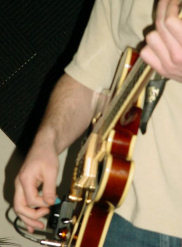 and 60's. Both the band and the attendees were very ecumenical, decades before that term was in circulation.
and 60's. Both the band and the attendees were very ecumenical, decades before that term was in circulation.
Music was provided by Cannon's Band whose members were themselves just out of their teens. It was fronted by Jimmy and John Cannon on trumpet and saxophone respectively, and the redoubtable Willie Hamilton on drums. The line up meant that the band could play the brass-led raucous rock-an-roll which was emerging from the USA as the new music of the 1950's, played by bands like Bill Haley and the Comets.
Haley was banned from performing live in some British cities, and his first film was accompanied by riots in some cinemas. This music was the enemy of right-thinking people across the US and Britain from churchmen to politicians. Hardly the stuff for douce Presbyterian Scots, you might have thought. Nobody in Bonhill, least of all Hasson, batted an eye - God worked in mysterious ways. The dances were a huge success both socially and financially for the BB's, and his church pews were filled with young people. Happy days indeed.
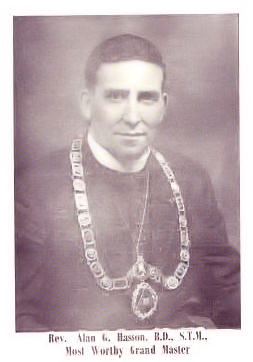 Some readers may also recall local
lad Tommy Lacey's band also appearing in the church hall. Tommy was brought up literally across the street from the church hall on Main street, Bonhill. It was Tommy who formed the popular local band "The
Executives" who
are still performing to this day although Tommy has long since moved on.
Some readers may also recall local
lad Tommy Lacey's band also appearing in the church hall. Tommy was brought up literally across the street from the church hall on Main street, Bonhill. It was Tommy who formed the popular local band "The
Executives" who
are still performing to this day although Tommy has long since moved on.
Sadly, Alan Hasson's church career ended in tears in the early 1970's. After he left Bonhill it was found that he had misappropriated Orange Order funds - to help the needy he claimed, and there were plenty of people in Bonhill who believed that, based on the evidence of their own eyes. He went to prison, in spite of the efforts of his defence solicitor, Joe Beltrami. He spent his last few years as a piper busking on the streets of Edinburgh and raising money for charity and died a few years ago without returning to visit Bonhill, where his ministry undoubtedly peaked.
By the 1960's plans were well advanced to build a large housing development on the Ladyton and Nobleston Farms above Bonhill. Much of the plan was based on housing what was termed “Glasgow Overspill”, which was an extension of the New Town system already deemed a success across central Scotland. There were a number of attractions to the plans, not least the promise of new jobs to go with the houses (these never materialised), but also a boost to the population and the associated increases in rating revenues etc that would come with that, and improvements to the infrastructure.
If there were any objections to the plans they were well hidden and are now long forgotten. The predominant feeling was one of warm welcome, not least because the estates finally removed the Vale's housing waiting list. From the early 1960's onwards, a series of new schemes started to spread up the hill. Basically, the nearer the estate is to what is termed “Old Bonhill”, the older it is. The first one to be started was Nobleston, which was originally built to house workers from the new Clyde Submarine Base back in the mid sixties. This was followed by Ladyton and then O'Hare, Redburn, High Dykes, Pappert and Braehead were all completed by the 1970's. Private development started at Strathleven in the early 1970's, soon to be followed by Beechwood.

The sprawling housing estates on the hill above Bonhill
Many other green spaces, particularly in the south of Bonhill, were built on in the 1980's and 90's. However, the continuing number of gaps sites in Old Bonhill remains a great puzzle, as does the state of some of the roads there.
By the late 1970's the new road system into the new hillside estates was working perfectly well. A bit of re-alignment of Burn Street and Hillbank Street had taken place, but as much of the existing Burn Street and Main Street as was practical had been maintained. Besides, there was room within the existing road system both to widen and re-align the roads if necessary.
One other factor was that while it was agreed that Bonhill Bridge was in need of imminent replacement, its actual alignment could be changed when it was replaced. A much-discussed plan was to build the new bridge at an angle from just south of Bridge Square on the Alexandria side to the entrance to Burn Street on the Bonhill side. This seemed to most people to be the best approach since it was obviously the least disruptive to surrounding buildings while meeting traffic needs. However, enter the planner.
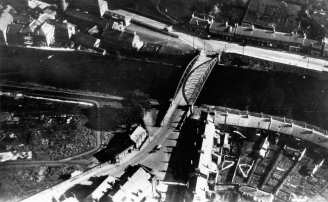
This
image shows an aerial view of the old Bonhill bridge
and its surroundings.
Most of the buildings in this
picture
are no more. Those that do survive include
the dentists' surgery and newsagents and the old Dalmonach School. (Click to Enlarge)
To replace Bonhill Bridge, it was apparently necessary to demolish all of the buildings on Main Street up to Burn Street, and then swing into Burn Street and demolish what little was left of that as well. Thus Bonhill lost most of its shops, many of which served the wider Vale community, two good pubs and two of the best chippies in the Vale.
And what did it get in return? A traffic bottleneck that was totally predictable and could be easily remedied - neither terms which seem to have any appeal to the relevant authorities. Why a lane is not added for south bound traffic on the east side of the Rainbow Bridge is anyone's guess. If anyone needs any help, here's a hint. Go to the Lomond Castle turn-off on the A82. Study the west side of the road very carefully for about 15 yards and learn the lesson. Start the road works at Bonhill Bridge traffic lights. It should take about a weekend to solve the problem. There is no fee for this piece of road planning consultancy.
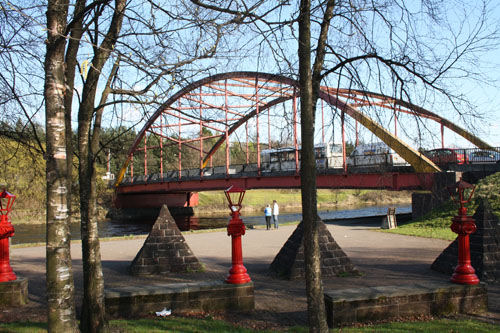
The images below show the demolition of the old Bonhill Bridge. Place your mouse pointer over these to see enlarged versions. Move pointer off images to reduce.
In the early 2000's there were apparently well-founded rumours that Tesco was going to build a superstore on what would have been an ideal site, the almost totally derelict Dalmonach Works. However,
the apparently Vale-averse West Dunbartonshire Council of the time deemed that there was already an oversupply of superstores in the area. Presumably, they meant Dumbarton and Clydebank  since there were
and are no superstores in the Vale.
since there were
and are no superstores in the Vale.
Tesco announced that they had dropped the idea. Lo and behold, the superstore oversupply has disappeared, in an apparently quite magical fashion, since no rational explanation has been offered, but Tesco are being allowed to build a new store, in Dumbarton.
However, Dalmonach has turned out to be a good news story. In the spring of 2006, plans were announced by Turnberry Homes to build houses on the site, and with the exception of the listed building of Dalmonach School, the site has been completely demolished and cleared. Many houses are already occupied at the time of writing (summer 2008) and the run-down old Works has been completely replaced by a very attractive riverside housing development.
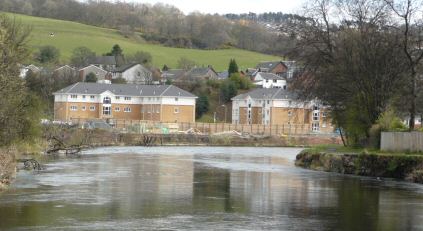
The views from Bonhill Bridge and on Jamestown Road have been completely transformed from gloom into a light, open aspect which makes the entrance to Bonhill very modern and bright, which is at it should be for the Vale's oldest town, which is well used to facing the challenges of the centuries.
PAGE 1 | PAGE 2 | PAGE 3 | PAGE 4

